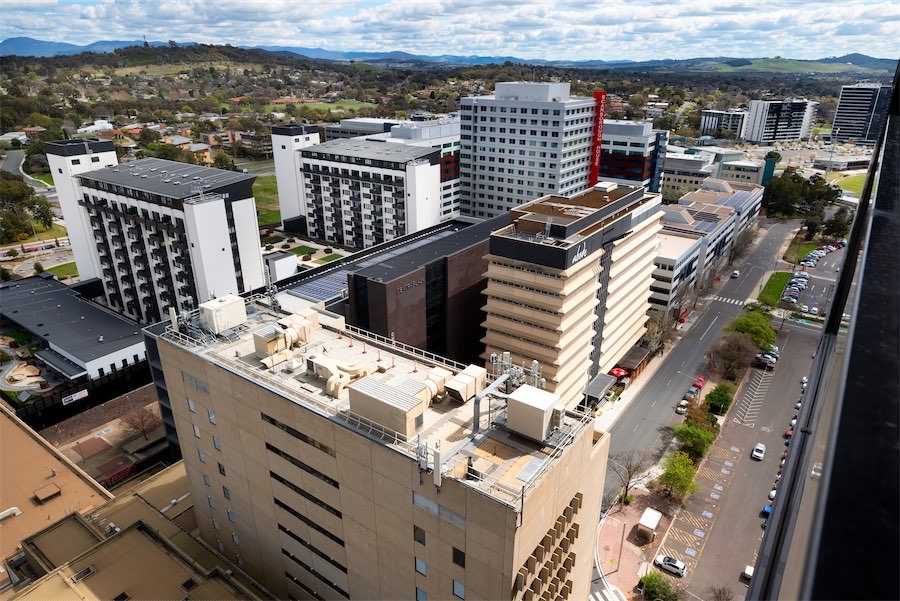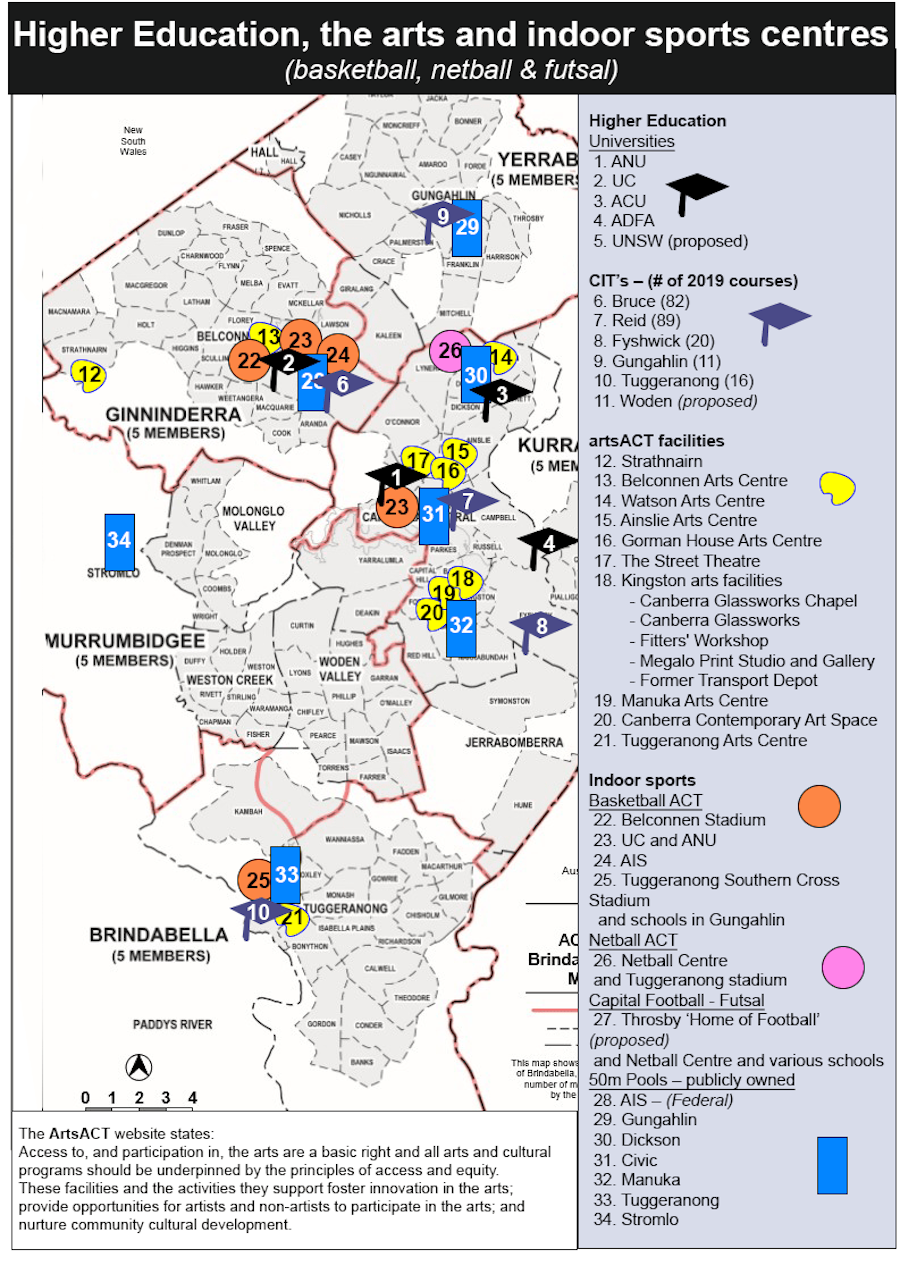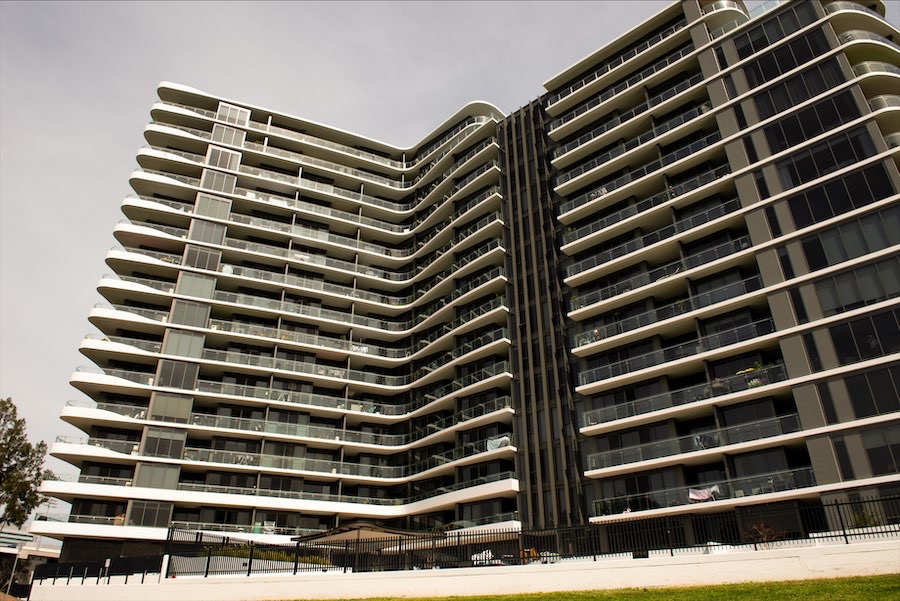
In this special feature, DANIELLE NOHRA looks at the development and community woes of Woden.
COMMUNITY groups, residents and members of the opposition are calling on the ACT government to explain why Woden Valley has been neglected for so long.
Major districts – Belconnen, Gungahlin, Molonglo Valley, north Canberra, south Canberra and Tuggeranong – have community centres, arts centres, higher education hubs and public sporting grounds, all of them except for Woden Valley and Weston Creek.
Woden Valley Community Council president Fiona Carrick’s lived in the area for more than 50 years and often gets teary from the ACT government’s planning mess in the south, particularly in Woden’s centre.
“Where’s our community centre, where’s our indoor sports stadium, where’s our arts centre, our pool’s on its way out,” she says.
“Where is the planning for the people? Where are the community facilities? Where are the public spaces in our town centre?”
Paul Costigan, an independent planning commentator and “CityNews” columnist, frequently attends council meetings in each ACT district – including Woden – and says he wouldn’t call what’s happening in Woden “planning”.
“We no longer do planning,” he says.
“There’s a certain level of facilities you would expect a community to be provided with. Woden hasn’t got them.”
Jeremy Hanson, a Canberra Liberals MLA for Murrumbidgee and former party leader, has been campaigning for a “better deal” for Woden since he was elected to the Legislative Assembly in 2008.
Now in his fourth term, Mr Hanson says there’s no doubt the people of Woden and Weston Creek have been treated as “second-class citizens”.
As a town centre, his vision is that Woden becomes “the CBD of the south”, but that said, he says it shouldn’t be a “free for all”.
“We’ve still got to have good urban design,” he says.
ACT Labor member for Murrumbidgee Chris Steel gave his inaugural parliamentary speech in 2016, and in it said: “If Canberra is the most liveable city in the world, then the southside is the most liveable part of the most liveable city in the world.”
It was a big call, and something that the minister still “absolutely” stands by.
However, he also acknowledged, in that speech, that there is a lot of work needed to be done at Woden town centre.
“The regeneration of that town centre has been one of the central things I’ve been working on as a member of the Assembly and as a minister,” he says.
“We’ve now really seen it turn a corner as a result of having a masterplan in place and as a result of public investment in the town centre, in public projects like the CIT, light rail, the community centre and other projects.”
When it comes to community facilities, Mr Steel points to investment going into projects such as a new CIT campus, a new public transport interchange, which will accommodate light rail, a new community centre, as well as upgrades to the Woden library, which would include new spaces for groups to meet and conduct activities such as art.
He also points to the performing arts centre that the government built in the Woden area almost a decade ago.
However, Tony Adams, who has more than 45 years’ experience in urban and regional planning in the public and private sector across all states of Australia, including the ACT, says Woden has copped a triple whammy of bad planning.
A life fellow of the Planning Institute of Australia, Mr Adams is now the principal of his own practice, A T Adams Consulting, which provides advice on planning and property development matters.
He says Woden has been subject to an overreaction of “fashionable” planning, which saw “separating supposedly incompatible land uses, thus cutting it off from its own community”.
It has also been subject to a belief that car transport was the best thing, as well as the commercial pressure that relocated all of Woden’s shopping from high streets into big-box malls, he says.
‘The Chief Minister’s priorities are Dickson to the lake’
THE LOCAL / FIONA CARRICK
WODEN is a major hub of Canberra’s south, yet it has no arts centre, no community centre and has lost multiple sporting facilities, says Woden Valley Community Council president Fiona Carrick.

“Where’s our community centre, where’s our indoor sports stadium, where’s our arts centre, our pool’s on its way out,” Ms Carrick says.
“Where is the planning for the people? Where are the community facilities? Where are the public spaces in our town centre?”
When talking of the neglect of the region, Ms Carrick, someone who has lived in the area for more than 50 years, describes the planning of the region as something that continues to get worse and worse.
“We’re not a priority,” she says.
“The Chief Minister’s priorities are Dickson to the lake and he has the City Renewal Authority to look after that.”
Ms Carrick believes the government should introduce a policy on the equitable distribution of sporting facilities for grassroots sports, arts centres and community centres, and there should be a focus on the main district hubs in the ACT.
“You’re not going to have a multi-purpose sports stadium or an arts centre at every group centre or at every local shop, that’s why you’ve got the four big town centres where the buses hub into,” she says.
“All the buses from the south hub into Woden, which is why there should be more care into the planning there,” she says.
She believes the town planning needs to go beyond high-rise residential apartments because the residents who live in the existing ones, or will move into the to-be-built residential towers, need community facilities and sports facilities to access.
“All these new people moving in, they didn’t even know that we had a basketball stadium,” she says.
“If you’re going to take it away, replace it. It’s heartbreaking.”
Woden Valley Community Council is not anti-development but it is anti bad development.
“There needs to be balance,” she says.
“One of the big issues with planning, particularly around the square,” she says, “is the zoning (up to 28 storeys) for residential towers at the expense of a recreation precinct.”
“The national capital plan has an urban hierarchy in it and it says that each town centre is supposed to be relatively self-contained with jobs and community facilities and you’re supposed to grow the jobs and the community facilities in the town centres and they’re supposed to be a focal point for the people,” Ms Carrick says.
Despite this plan, she says the town centre has more of a focus on residential towers.
“You can put as many people in here as you like but if it’s not nice placemaking, people will just get in their cars and drive somewhere else,” she says.
Ms Carrick says the 28-storey towers have also resulted in the town square becoming over-shadowed and windy.
“The council does not support the building hierarchy that allows 12 to 28-storey buildings across the centre with the town square limited to three hours of sunlight on one quarter of the square in winter,” she says.
When the centre experiences strong westerly winds, Ms Carrick says the wind hits the tower, creating a vacuum where the wind rushes through to the town square.
“For people with mobility issues it is really quite dangerous because the wind gets quite strong,” she says.
“There’s no accountability, who’s responsible for this being a good place?”
While the council understands that there’s a desire to have people in the town centre to help activate it, they’d like to see more jobs created around the town centre as well.
“We don’t want all our office blocks slowly but surely turning into residential buildings. You need that balance,” she says.
“We accept the need for infill and the town centres are doing the heavy lifting for this policy.
“The debate should include the future of our town centres and whether they are being planned for a balance between homes, jobs, public (green) spaces and community facilities – connecting people to jobs and friends and facilitating physical and mental health outcomes.
“People are not served well by the dormitory, overshadowed, windy concrete jungles where we have to drive to other places for entertainment, culture and recreation.”

‘We pay huge amounts in taxes, but very little is coming back’
THE POLITICIAN / JEREMY HANSON
CANBERRA Liberals MLA Jeremy Hanson believes population density in Woden town centre is the only way to bring life back into Woden, but it needs to be part of a masterplan and it needs to be thought through.

“At the moment, the town centre is a bleak desolate place where no one goes,” he says.
“What having apartments around the town square can do is create vibrancy and it will mean that there will be cafes, there will be bars, there will be restaurants.
“Once you have sufficient population there, hopefully it will see those businesses open and certainly we should be doing what we can to encourage that but if you were a cafe owner or a bar owner, you’re not going to open a bar where there are no people.”
Mr Hanson’s been campaigning for a “better deal” for Woden since he was elected into parliament in 2008.
Now in his fourth term, Mr Hanson says there is no doubt that the people of Woden and Weston Creek have been treated as “second-class citizens”.
As a town centre, his vision is that Woden becomes “the CBD of the south” but that said, he says it shouldn’t be a “free for all”.
“We’ve still got to have good urban design,” he says.
Mr Hanson believes Woden and Weston Creek deserve better support; from planning to delivery.
“And it should not be tied to removing current facilities,” he says.
There is still no certainty for the Phillip ice rink and pool, for example, which has been left in doubt following the government’s commitment to build a new rink in Tuggeranong.
On sporting facilities, Mr Hanson has also campaigned for support for a properly equipped, multi-use sports facility, saying that the remaining “bare” ovals in Woden simply aren’t good enough.
“But there is also a level of local amenity that needs planning, maintenance and support,” he says.
“Not every green space needs to be a full sports field, but they do need to be maintained and functioning.”
While Mr Hanson says Woden’s centre, in particular, has been woefully neglected, he believes that the Phillip business area has been neglected, too.
“As I walk our streets doorknocking or letterboxing, I am still appalled by the state of some of our streets and footpaths,” he says.
“I think it’s a lot to do with a ‘north-centred’ government, and local members from the Greens and Labor who have not been able to stand up effectively for local residents.
“I can’t count how many times I have seen a Greens member side with residents when out on the streets, but cave and side with the government once they were back in the Assembly.”
But, whether it’s Woden’s town centre or Phillip, Mr Hanson believes that it’s the government’s job to create the environment where businesses can flourish.
“We have had years of business being hit with massive taxes if they wanted to change their lease, enormous increases in commercial rates and huge hikes in charges like land tax,” he says.
“Combine that with neglect and progress becomes near impossible.
“This is all on top of the increases in rates that every single household has had to suffer. Rates have, as we warned, tripled.
“In some suburbs in the area they are going up well over 10 per cent every year. And this is for people whose only main asset is the home they bought in the ‘70s or ‘60s.
“We pay huge amounts in government taxes and charges, but very little is coming back – it’s all been focused on the inner city suburbs north of the lake.”
When it comes to delivering on better planning in Woden, Mr Hanson says it’s important to look at multiple factors, such as attracting local employers, high government charges, the local streetscape and amenity, and proper planning processes need to be in alignment and informed by experts and locals to get the best outcomes.
He welcomes re-energising the area after so many years of neglect but says good planning should always be central to this process.
“You rarely get a chance to fix it afterwards, but you do get a chance to get it right in the first place,” he says.
“There has been a real failing in this government for a very long time on planning – we’re getting the wrong developments, in the wrong places for the wrong reasons.
“The fact that the Planning Minister recently announced a complete rewrite of the Planning Act shows just how bad the situation has become.”
And when it comes to the region, Mr Hanson can’t look past light rail, saying it’s a major issue.
“It is a mistake to think that this government is using light rail as a transport solution,” he says.
“The government is using light rail as an excuse for massive development.
“Based on the government’s record, I am greatly concerned about what this will mean.
“I am concerned about how up-front the government is going to be. At the last election there was no mention of four years of traffic chaos and delays, there is no detail about how much development will be put on Adelaide Avenue and Yarra Glen and there is still no firm cost.
“[And] I certainly do not support Labor’s position of telling women in Woden they should prepare to get a bus or ride a scooter!”
Mr Hanson says the next stage of the light rail will shape the area for decades to come, which is why it must be done right.

‘We’ve now really seen the town centre turn a corner’
THE MINISTER / CHRIS STEEL
WHEN it comes to town centres, ACT Labor member for Murrumbidgee Chris Steel says the ACT government is currently making one of its largest investments in Woden.

“Our vision for Woden is to see the town centre become a great place to live, work, to study and to do business,” says Mr Steel, who lives in Kambah but grew up in Torrens.
The 35-year-old continues to call Woden his hometown, and, as part of his inaugural parliamentary speech in 2016, said: “If Canberra is the most liveable city in the world, then the south side is the most liveable part of the most liveable city in the world.”
It was a big call, and something that the minister still “absolutely” stands by.
However, he also acknowledged, in that speech, that there is a lot of work needed to be done at Woden town centre.
“The regeneration of that town centre has been one of the central things I’ve been working on as a member of the Assembly and as a minister,” he says.
“We’ve now really seen it turn a corner as a result of having a masterplan in place and as a result of public investment in the town centre, in public projects like the CIT, light rail, the community centre and other projects.”
When it comes to community facilities, Mr Steel points to investment going into projects such as a new CIT campus, a new public transport interchange, which will accommodate light rail, a new community centre, as well as upgrades to the Woden library, which will include new spaces for groups to meet and conduct activities such as art, and will be available to use after-hours as well, with recording studios, large community meeting spaces and kitchens available to the community.
He also points to the performing arts centre that the government built in the Woden area in 2014 and Phillip oval.
“This is all public investment, but what we’re seeing in Woden over the last five years, in particular since the Woden town centre masterplan was put in place, is a substantial private-sector investment as well,” Mr Steel says.
“When I came into the Assembly in 2016, a large number of buildings in Woden were empty or derelict.
“Those commercial buildings have now been converted into residential properties supporting the regeneration.
“Just a few years ago Woden had no residential in the town centre and so it was a place that people came to work and then after those working hours the place was dead.
“On a weekend, the only life you used to see in the Woden Town Square was the tumbleweed of a plastic bag floating through the square.
“We had a view through the masterplan that there should be more mixed use development, so both residential and commercial development, but also other uses, like education brought into the town centre, is key to bringing vibrancy to the centre.”
Mr Steel also gives credit to the Bradley Street development by Westfield, which is the new dining precinct there.
“[It’s] brought more vibrancy to the town centre so it really has turned a corner,” he says.
While Woden, the centre of one of Canberra’s major districts, doesn’t have a community arts centre, the government is providing a space in the Woden library upgrades that can be used for dirty activities such as artmaking, Mr Steel says.
“We will consult with the community further about how they would like to use the spaces for visual arts and those types of activities as well,” he says.
“It’s likely to be a flexible space that can be used for a variety of different activities.”
When it comes to the planning of Woden town centre, Mr Steel says its masterplan, which was made on the basis of community consultation several years ago, guides the development around the town centre.
As for the height of the buildings there, he says Woden has always had large, tall buildings, such as the Lovett Tower (formerly known as the MLC Building), which was built in the 1970s.
“It’s nothing new to Woden,” he says.
Mr Steel’s personal view about these types of developments is that they’re done well and also that town centres are a good place for high-density development rather than doing it in the suburbs.
“It’s close to amenities, it helps to bring vibrancy to the town centre and it’s not impacting on the character of the Woden Valley suburbs and other people who are living in the town centre,” he says.
“The masterplan has set the planning and land-use requirements around the town centre and now we’re getting on with delivering that vision under the masterplan.”
However, Mr Steel does admit that some of the environment in Woden is really challenging to plan for.
“It’s traditionally been a space that has a very low canopy cover [and is] a bit of a concrete jungle,” he says.
“That’s why as part of the planned investment in the town centre, like the new CIT Woden campus, we’re looking at enhancing the canopy cover and introducing new, soft elements to make it a much better place to be for people,” he says.
Overall, Mr Steel believes Woden town centre has come a really long way, and while there’s still a lot of construction work that needs to be done, he says the southside is going to be even more liveable once the enhancement of the centre is complete.
He says it’s going to be quite disruptive for the community during that period, but the enhancements will benefit the whole region when they’re complete.
‘It hasn’t delivered on what most people look for in a town centre’
THE PLANNER / TONY ADAMS
WODEN’S copped a triple whammy of bad planning, according to Tony Adams, a man with more than 45 years’ experience in urban and regional planning in the public and private sector across all states of Australia, including the ACT.

A life fellow of the Planning Institute of Australia, Mr Adams is now the principal of his own practice, A T Adams Consulting, which provides advice on planning and property development matters.
He says Woden has been subject to an overreaction of “fashionable” planning, which saw it “separating supposedly incompatible land uses, thus cutting it off from its own community”.
It has also been subject to a belief that car transport was the best thing, as well as the commercial pressure that relocated all of Woden’s shopping from high streets into big-box malls.
To understand, he goes into the town centre’s history, which was designed by the National Capital Development Commission (NCDC) in the 1960s.
“At that time the NCDC was following the then very fashionable ‘garden city’ approach to city planning,” he says.
The garden city movement was started by Ebenezer Howard in England in 1902 when he published his book “Garden Cities of Tomorrow”, something Mr Adams calls a response to the unsanitary overcrowding of British 18th century industrial cities where dirty factories and crowded housing were all lumped in together.
“The solution was to separate the various land uses – commercial, industrial, residential – from each other,” he says.
“That is why the Woden commercial centre is separated from the surrounding residential areas.”
Mr Adams says the separation is achieved by four to six-lane arterial roads. “Contrast this with, say, Chapel Street or Lygon Street in Melbourne where the commercial ‘High Street’ blends into the surrounding residential areas,” he says.
“Both of these are renowned for their life and vibrancy; they are set within, and are part of, their surrounding community, walkability is the key.”
Woden is the opposite, he says.
“Walking to and from surrounding residential areas is not a comfortable experience,” he says.
“And this is all made worse because of the timing of the Woden design.”
Being designed in the ‘60s – the age of the car and the shopping mall – Mr Adams says the centrepiece of the town centre was a big blank box shopping mall, which people were expected to travel to by car.
If the goal for Woden town centre was to have life, people, activity and vibrancy, Mr Adams says Woden got off to a very poor start.
“In fact it was a big negative,” he says.
“It has worked terrifically well as a car-based shopping mall, and generations of Woden folk will attest to this, but it hasn’t delivered on what most people look for in a town centre – some life and vibrancy and a focal point for the community.”
The solution, he says, is to install residents, as many as possible, into the centre itself to generate liveliness and activity, seven days a week and into the nights.
“That is what the masterplanning is trying to do, but inevitably, because it is a retro-fitting exercise (the NCDC never envisaged any residential in the town centre) the results won’t be perfect,” he says.
“A good way to get lots of people into a small space is to go upwards with higher rise residential developments.
“I say ‘higher’ rather than ‘high’ rise because the permissible heights at Woden are not what the world would call ‘high-rise’.
“From my reading of the Territory Plan, the highest possible tower at Woden is 24 storeys, in a limited area, with lower heights elsewhere in the centre.
“The Gold Coast, Sydney and Melbourne boast residential towers of 60 and 70-plus storeys. The World Tower in Sydney is 75 storeys, designed by Fender Katsalidis, who designed the prize winning Nishi building at New Acton.”
Mr Adams says the residential buildings at Woden will bring (and already are bringing) the much-needed residential population into the centre.
“This will enliven the centre and benefit everyone in the valley,” he says.
On concerns about the costs of taller buildings that are overshadowing and sometimes cause wind effects, Mr Adams says these can be minimised with good design controls.
“The controls in the Territory Plan will, I am sure, go some way to achieving this,” he says.
But, he says, the benefits go beyond the creation of a better town centre. “We need to remember that for every single person, couple, or family that move into the residential complexes in the town centre, there will be a few more car trips replaced by public transport or walking, there will be less pressure on ‘infill’ residential developments, which cause so much angst in the suburbs, and there will be demand for one less new block in a greenfields development on the fringe of the metropolis,” he says.
“It’s not the life that all of us would choose, but for those who do move into the town centre, they are actually doing the rest of us a favour.”
Who can be trusted?
In a world of spin and confusion, there’s never been a more important time to support independent journalism in Canberra.
If you trust our work online and want to enforce the power of independent voices, I invite you to make a small contribution.
Every dollar of support is invested back into our journalism to help keep citynews.com.au strong and free.
Thank you,
Ian Meikle, editor







Leave a Reply